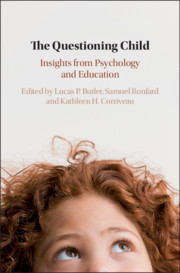Book contents
- The Questioning Child
- The Questioning Child
- Copyright page
- Dedication
- Contents
- Figures
- Tables
- Contributors
- 1 Questions about Questions
- 2 Questions in Development
- 3 The Point, the Shrug, and the Question of Clarification
- 4 The Quest for Comprehension and Learning
- 5 Children’s Question-Asking across Cultural Communities
- 6 The Development of Information-Requesting Gestures in Infancy and Their Role in Shaping Learning Outcomes
- 7 Developmental Changes in Question-Asking
- 8 Understanding Developmental and Individual Differences in the Process of Inquiry during the Preschool Years
- 9 “Why Are There Big Squares and Little Squares?”
- 10 Children’s Questions in Social and Cultural Perspective
- 11 Mothers’ Use of Questions and Children’s Learning and Language Development
- 12 Teaching and Learning by Questioning
- 13 Asking “Why?” and “What If?”
- 14 What Makes a Good Question? Towards an Epistemic Classification
- 15 The Questioning Child
- Index
- References
9 - “Why Are There Big Squares and Little Squares?”
How Questions Reveal Children’s Understanding of a Domain
Published online by Cambridge University Press: 10 January 2020
- The Questioning Child
- The Questioning Child
- Copyright page
- Dedication
- Contents
- Figures
- Tables
- Contributors
- 1 Questions about Questions
- 2 Questions in Development
- 3 The Point, the Shrug, and the Question of Clarification
- 4 The Quest for Comprehension and Learning
- 5 Children’s Question-Asking across Cultural Communities
- 6 The Development of Information-Requesting Gestures in Infancy and Their Role in Shaping Learning Outcomes
- 7 Developmental Changes in Question-Asking
- 8 Understanding Developmental and Individual Differences in the Process of Inquiry during the Preschool Years
- 9 “Why Are There Big Squares and Little Squares?”
- 10 Children’s Questions in Social and Cultural Perspective
- 11 Mothers’ Use of Questions and Children’s Learning and Language Development
- 12 Teaching and Learning by Questioning
- 13 Asking “Why?” and “What If?”
- 14 What Makes a Good Question? Towards an Epistemic Classification
- 15 The Questioning Child
- Index
- References
Summary
Children struggle to identify the defining properties of shapes through elementary school (Satlow & Newcombe, 1998). Perhaps preschoolers struggle to learn these properties because they have little conception of what constitutes relevant shape knowledge or how to go about acquiring it. We outline empirical support for the idea that children’s questions show us not only what a child knows in a given domain, but how that child is approaching the act of knowledge acquisition itself. In this way, studying children’s questions provides information that cannot be gleaned from studies which simply test children’s domain–specific knowledge. To illustrate this point, we examine existing research into children’s questions about animals, to show how this idea applies in relation to an extensive body of research on children’s questioning behavior. Second, we review our own study of children’s questions about shapes, to see how preschoolers’ approach to knowledge acquisition differs in a domain composed of pure nominal kinds rather than natural kinds. Our results suggest that, in contrast to the animal domain, three–year–olds demonstrate very little awareness of relevant information in the shape domain. We conclude by considering why this might be the case and suggesting some ways it could be rectified.
Information
- Type
- Chapter
- Information
- The Questioning ChildInsights from Psychology and Education, pp. 164 - 182Publisher: Cambridge University PressPrint publication year: 2020
References
Accessibility standard: Unknown
Why this information is here
This section outlines the accessibility features of this content - including support for screen readers, full keyboard navigation and high-contrast display options. This may not be relevant for you.Accessibility Information
- 1
- Cited by
